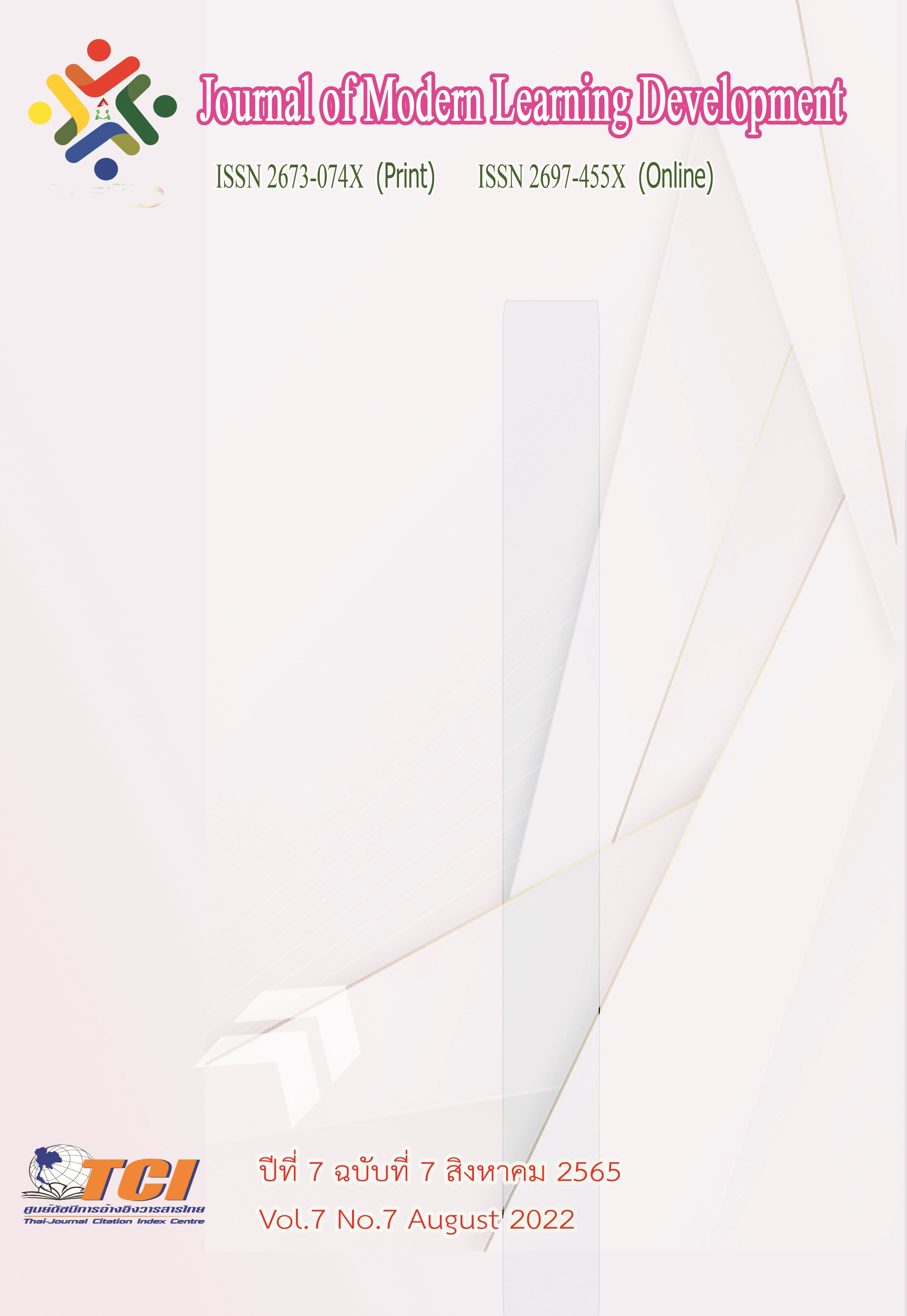The Effects of Constructivist Theory through Active Learning on Mathematical Learning of Education Students Majoring in Mathematics at Phranakhon Rajabhat University
Main Article Content
Abstract
The purposes of this research were 1) to develop mathematical learning activities based on constructivist theory through active learning of education students majoring in mathematics, Bachelor of Education, Phranakhon Rajabhat University, and 2) to study the effects of mathematics learning of education students majoring in mathematics, Bachelor of Education, Phranakhon Rajabhat University.
This research was the Quasi – Experimental Research. The sample of this research was 26 second-year students who studied in the program of Bachelor’s Degree of Education in Mathematics, College of Teacher Education, Phranakhon Rajabhat University in academic year 2021, which obtained from the cluster random sampling.
The research instrument consisted of lesson plans, learning achievement test, and the survey on opinions towards mathematical learning development. The data collection of this research was taken in the second semester of academic year 2021, and was taken 24 hours for research testing. The statistics for analyzing the collected data were frequency, percentage, mean, standard deviation, and One Sample t-test.
The results revealed that:
1. The effects of mathematical learning activities based on constructivist theory through active learning of education students majoring in mathematics, Bachelor of Education, Phranakhon Rajabhat University enabled students’ self-directed learning in the class via six lesson plans. Each lesson plan represented:
Step 1: Introduction - introduce the lesson or review the prior knowledge.
Step 2: Situation Presenting - present the situations or events related to the topics students want to learn.
Step 3: Activities - enable students to link their knowledge to the lessons which will transform into new knowledge.
Step 4: Conclusion - conclude new knowledge and lead learning achievement.
Step 5: Feedbacks - give students the opportunity to express their opinions and suggestions.
2. The effects of mathematical learning development based on constructivist theory through active learning were:
2.1 The mean level of learning achievement score was at 14.42 (72.10%) and standard deviation was 2.30. The learning achievement score of 65 percent of students was higher than standards with statistical significance at the level of 0.5. There were 19 students whose learning achievement score was at 70 percent or higher (73.08 percentage).
2.2 21 students (80.77%) were able to summarize their mathematical knowledge completely after learning based on the mathematical activities. After the instructors gave feedbacks and suggestions, students could summarize their mathematical knowledge correctly and accurately.
2.3 The results of students' opinion survey towards the development of mathematics learning found that the mean level was 4.55 and the standard deviation of 0.52 which was at the strongly agree level. The opinions at the strongly agree level were found in 6 questions and the opinions at agree level were found in 4 questions.
Article Details
References
ทัณฑวัต ปานพุ่ม และชมนาด เชื้อสุวรรณทวี. (2560). ผลของการจัดการเรียนรู้โดยใช้บริบทเป็นฐานร่วมกับการเขียนบันทึกการเรียนรู้เรื่องอัตราส่วน สัดส่วนและร้อยละที่มีต่อผลสัมฤทธิ์ทางการเรียนคณิตศาสตร์และความสุขในการเรียนของนักเรียนระดับประกาศนียบัตรวิชาชีพชั้นปีที่ 1 วิทยาลัยพณิชยการธนบุรี. Journal of nakhonratchasima college. 11 (2), 105 – 118.
พิมพันธ์ เดชะคุปต์และพเยาว์ ยินดีสุข.(2560). การเขียนแผนบูรณาการบนฐานเด็กเป็นสำคัญ. กรุงเทพมหานคร: โรงพิมพ์แห่งจุฬาลงกรณ์มหาวิทยาลัย.
บุญเลี้ยง ทุมทอง. (2554). การวิจัยการเรียนรู้ทางคณิตศาสตร์. มหาสารคาม: มหาวิทยาลัยมหาสารคาม.
มหาวิทยาลัยราชภัฎพระนคร. (2562). หลักสูตรครุศาสตรบัณฑิต สาขาวิชาคณิตศาสตร์ (4 ปี) หลักสูตรปรับปรุง พุทธศักราช 2562. กรุงเทพมหานคร: วิทยาลัยการฝึกหัดครู มหาวิทยาลัยราชภัฎพระนคร.
ลักขณา สริวัฒน์. (2557). จิตวิทยาสำหรับครู. กรุงเทพมหานคร: โอ.เอส.พริ้นติ้งเฮ้าส์.
วิจารณ์ พานิช.(2562). การสร้างการเรียนรู้สู่ศตวรรษที่ 21. ออนไลน์. สืบค้นเมื่อ 20 มกราคม 2565. แหล่งที่มา: http://www.scbfoundation.com/publishing.php?project id=292#publishing/ 292/5466.
สุนิสา ภามาศ และคณะ. (2561). ผลการจัดการเรียนรู้ตามแนวคิดทฤษฎีคอนสตรัคติวิสต์ ที่มีต่อผลสัมฤทธิ์ทางการเรียนวิชาคณิตศาสตร์ เรื่อง เลขยกกำลัง ของนักเรียนชั้นมัธยมศึกษาปีที่ 1. วารสารวิจัยทางการศึกษา คณะศึกษาศาสตร์ มหาวิทยาลัยศรีนครินทรวิโรฒ. 13 (2), 184-193.
อรุณ มาวัน. (2549). ผลสัมฤทธิ์ทางการเรียนกลุ่มสาระการเรียนรู้คณิตศาสตร์ ของนักเรียนชั้นมัธยมศึกษา ปีที่ 1 โดยใช้รูปแบบการเรียนรู้ตามแนวคิดของทฤษฎีคอนสตรัคติวิสต์. วิทยานิพนธ์สาขาวิชาหลักสูตรและการสอน. บัณฑิตวิทยาลัย: มหาวิทยาลัยขอนแก่น.
อัมพร ม้าคนอง. (2543). การสอนตามแนวคิด Constructivist ในชั้นเรียนคณิตศาสตร์. วารสารครุศาสตร์. 29 (1), 74-80.
Alsup John. (2004). A constructivism in the mathematics classroom: towards a newapproach. Online. retrieved June 15, 2016, from website : christinateskey.ca/metcourses/ 590pages/530constructivism-math.html.
Bednar, A., Cunningham, D. J., Duffy, T., & Perry, D. (1995). Theory in practice : How do we link? In G. Anglin (Ed.), Instructional Technology : Past, present, and future. (2nd ed). Englewood, CO : Libraries Unlimited.
Bonwell, C. C., &Eison, J. A. (1991). Active Learning : Creating Excitement in the Classroom. Washington, DC. : ERIC Clearinghouse on Higher Education, George Washington University.
DeVries, R. and Kohlberg, L. (1987).Constructivist early education and comparison with other Programs. Washington, DC. : National Association for the Education of Young Children.
Felder, R. & Brent, R. (1996). Navigating the Bumpy Road to Student – Centered Instruction. Journal of College Teaching. 44 (2), 43 – 47.
Meyers, C., & Jones, T. B. (1993). Promoting Active Learning : Strategies or the College Classroom. San Francisco: Josey – Bass Publishers.
Riley, M. J. (1981). Management Information System. (2nd ed). San Francisco : Holden-Day.


